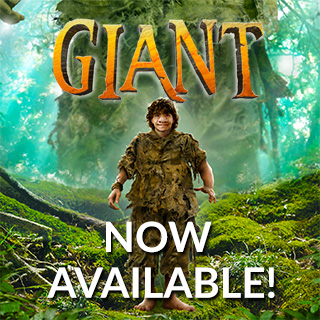A Future So Bright
Interview by Katie O’Reilly
Sierra – The Magazine of the Sierra Club
October 25, 2016
Original Article | PDF
Sierra – The Magazine of the Sierra Club
October 25, 2016
Original Article | PDF
Young adult author T. A. Barron is known for protagonists who slay dragons and unearth fantastical cities. Yet Barron is equally dedicated to championing real life’s inspiring young people. In 2001, he founded the Gloria Barron Prize for Young Heroes to celebrate North America’s most public-spirited youths. Named after the author’s mother, a teacher who created a nature museum at the Colorado School for the Blind, the award bestows a $5,000 cash prize on young people who have made a significant improvement on the environment and/or on social and humanitarian causes.
In 2016, about 400 youths active in wildlife conservation, social and environmental justice, and technological innovation competed for 15 awards. To get to know the environmental leaders of tomorrow—many of whose efforts are already affecting change—Sierra checked in with the winners. Read on to find out what each plans to do when she or he “grows up.”
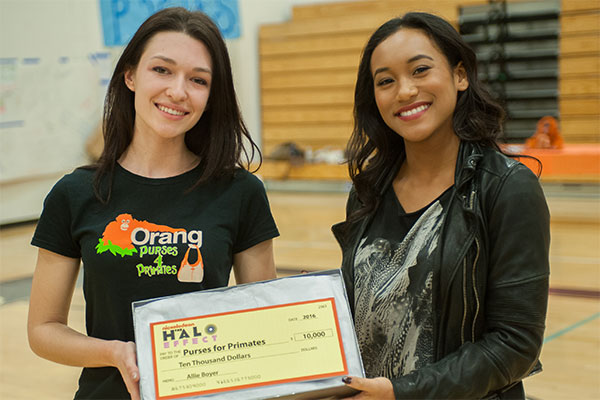 After reading Koko’s Kitten, about the famed gorilla’s friendship with a cat, seven-year-old Allison “Allie” Boyer started researching great apes. Stunned to learn the gentle, intelligent orangutan was facing extinction due to the destruction of the Malaysian rainforest for palm-oil plantations, Boyer rallied her classmates’ families to boycott palm oil. In seventh grade, she started collecting gently used handbags from across the United States, reselling them at fundraising “purse parties,” and donating the proceeds to Orangutan Outreach. Boyer’s nonprofit, Purses for Primates, has since raised more than $27,000 to protect her favorite animal. Boyer, now a freshman studying event-planning and anthropology at California State University Chico, plans to dedicate her career to rainforest preservation, but in the meantime, says palm-oil awareness is her mission. “The more consumers know about the most common types of palm oil and their products’ impact, the more I find they’re willing to help out.”
After reading Koko’s Kitten, about the famed gorilla’s friendship with a cat, seven-year-old Allison “Allie” Boyer started researching great apes. Stunned to learn the gentle, intelligent orangutan was facing extinction due to the destruction of the Malaysian rainforest for palm-oil plantations, Boyer rallied her classmates’ families to boycott palm oil. In seventh grade, she started collecting gently used handbags from across the United States, reselling them at fundraising “purse parties,” and donating the proceeds to Orangutan Outreach. Boyer’s nonprofit, Purses for Primates, has since raised more than $27,000 to protect her favorite animal. Boyer, now a freshman studying event-planning and anthropology at California State University Chico, plans to dedicate her career to rainforest preservation, but in the meantime, says palm-oil awareness is her mission. “The more consumers know about the most common types of palm oil and their products’ impact, the more I find they’re willing to help out.”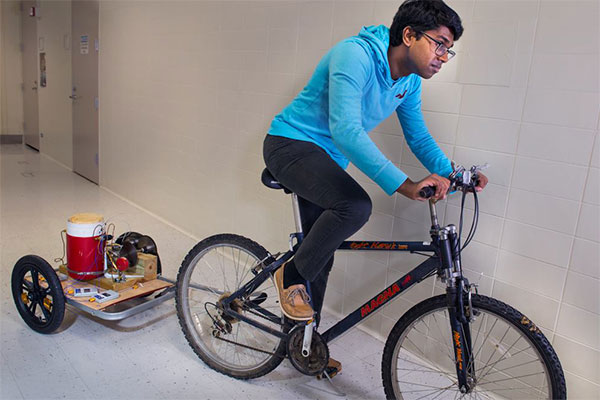 When Anurudh Ganesan was an infant in southern India, his grandparents carried him 10 miles to a vaccine clinic, only to find the vaccines weren’t properly refrigerated and couldn’t be administered. When he was older, after his family had immigrated to the United States, Ganesan heard this story and figured that if he’d been affected, many others must have, too. He went online and learned that 1.5 million children die annually due to vaccine-preventable illnesses. “They either weren’t reaching remote places or were rendered useless in transit,” explains the 16-year-old. Ganesan’s research resulted in the Vaxxwagon, a wheel-powered “no ice, no electricity” cooling system that keeps vaccines viable during the last leg of transport to remote locations. His invention can be hitched to a bike or pulled, and he’s working with Americares Foundation to get it out into the field. Ganesan, a high school senior, seems to have found his niche in social entrepreneurship. “I see myself going into businesses, investing in initiatives that help the less fortunate.”
When Anurudh Ganesan was an infant in southern India, his grandparents carried him 10 miles to a vaccine clinic, only to find the vaccines weren’t properly refrigerated and couldn’t be administered. When he was older, after his family had immigrated to the United States, Ganesan heard this story and figured that if he’d been affected, many others must have, too. He went online and learned that 1.5 million children die annually due to vaccine-preventable illnesses. “They either weren’t reaching remote places or were rendered useless in transit,” explains the 16-year-old. Ganesan’s research resulted in the Vaxxwagon, a wheel-powered “no ice, no electricity” cooling system that keeps vaccines viable during the last leg of transport to remote locations. His invention can be hitched to a bike or pulled, and he’s working with Americares Foundation to get it out into the field. Ganesan, a high school senior, seems to have found his niche in social entrepreneurship. “I see myself going into businesses, investing in initiatives that help the less fortunate.”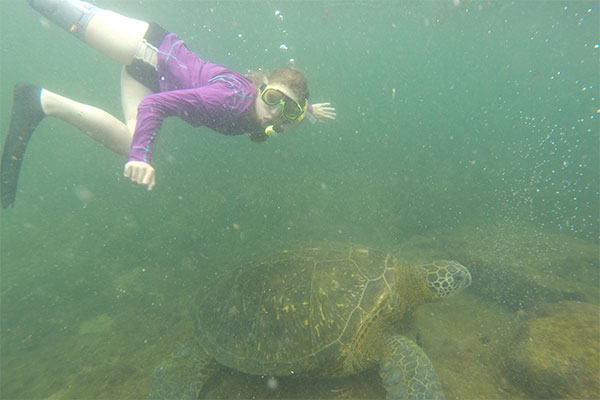 Delaney Reynolds, who grew up in Miami and No Name Key, a 1,000-acre island in the Florida Keys, became concerned about sea-level rise at an early age. So, she founded The Sink or Swim Project to educate and engage young South Floridians in political action around climate change. “Kids get it,” says Reynolds, who last year mobilized Miami-Dade County to appoint its first-ever chief sustainability officer, and who’s currently working with the mayor of South Miami to implement an ordinance requiring solar power on new and renovated buildings. “We see evidence of sea-level rise all around us and understand it’s on our generation to solve the problem.” The tireless 16-year-old, who already plans to pursue a doctorate in marine biology or climatology, has already spread her message via a TEDx Talk. And on the October 30 premiere of National Geographic Channel’s Years of Living Dangerously, she’ll be schooling actor Jack Black on climate science.
Delaney Reynolds, who grew up in Miami and No Name Key, a 1,000-acre island in the Florida Keys, became concerned about sea-level rise at an early age. So, she founded The Sink or Swim Project to educate and engage young South Floridians in political action around climate change. “Kids get it,” says Reynolds, who last year mobilized Miami-Dade County to appoint its first-ever chief sustainability officer, and who’s currently working with the mayor of South Miami to implement an ordinance requiring solar power on new and renovated buildings. “We see evidence of sea-level rise all around us and understand it’s on our generation to solve the problem.” The tireless 16-year-old, who already plans to pursue a doctorate in marine biology or climatology, has already spread her message via a TEDx Talk. And on the October 30 premiere of National Geographic Channel’s Years of Living Dangerously, she’ll be schooling actor Jack Black on climate science.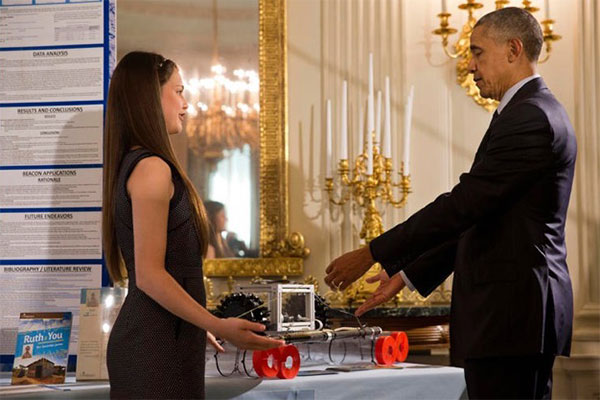 When Hannah Herbst of Boca Raton, Florida, was in fourth grade, she realized her Ethiopian pen pal, Ruth, had little access to electricity. “Sometimes she had it, sometimes she didn’t,” Herbst says, “which made it difficult to study and get fresh water—things I took for granted.” In response, she invented a device that converts kinetic energy from ocean tides into electricity. The BEACON (Bringing Electricity Access to Countries through Ocean ENergy) costs $12 to make, uses recycled materials such as two-liter bottles, and powers desalination pumps in energy-scarce areas. “I’m working on making kits, so middle-school kids can build them anywhere,” reports Herbst. The 16-year-old is already working on a second invention—one powered by small sensors to identify airborne chemicals and alert emergency first responders.
When Hannah Herbst of Boca Raton, Florida, was in fourth grade, she realized her Ethiopian pen pal, Ruth, had little access to electricity. “Sometimes she had it, sometimes she didn’t,” Herbst says, “which made it difficult to study and get fresh water—things I took for granted.” In response, she invented a device that converts kinetic energy from ocean tides into electricity. The BEACON (Bringing Electricity Access to Countries through Ocean ENergy) costs $12 to make, uses recycled materials such as two-liter bottles, and powers desalination pumps in energy-scarce areas. “I’m working on making kits, so middle-school kids can build them anywhere,” reports Herbst. The 16-year-old is already working on a second invention—one powered by small sensors to identify airborne chemicals and alert emergency first responders.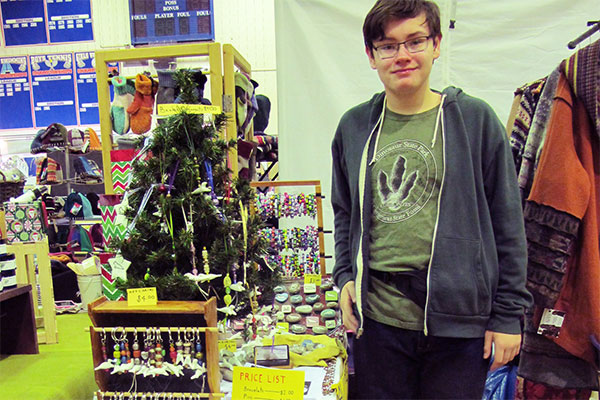 Martin Welych-Flanagan had been designing and selling beaded bracelets to earn cash for a Lego set when he learned of Canada’s commercial baby harp seal hunt. The seven-year-old switched gears and started crafting goods depicting his favorite animal. For nine years now, the 15-year-old from Syracuse, New York, has been selling handmade seal-themed keychains, magnets, ornaments, figurines, and fleece finger puppets, all to benefit the Humane Society of the United States’ Protect Seals program. Welych-Flanagan also petitions politicians and delivers presentations about the seal-fur trade, his Save the Seals campaign, and the toll climate change wreaks on Arctic ecosystems. Welych-Flanagan, who plans to study paleoclimatology, is well aware that it can take time to see the impacts of one’s work. “It’s important to take a long-term view,” he says, “because even if you don’t see immediate effects, your work is making a difference.”
Martin Welych-Flanagan had been designing and selling beaded bracelets to earn cash for a Lego set when he learned of Canada’s commercial baby harp seal hunt. The seven-year-old switched gears and started crafting goods depicting his favorite animal. For nine years now, the 15-year-old from Syracuse, New York, has been selling handmade seal-themed keychains, magnets, ornaments, figurines, and fleece finger puppets, all to benefit the Humane Society of the United States’ Protect Seals program. Welych-Flanagan also petitions politicians and delivers presentations about the seal-fur trade, his Save the Seals campaign, and the toll climate change wreaks on Arctic ecosystems. Welych-Flanagan, who plans to study paleoclimatology, is well aware that it can take time to see the impacts of one’s work. “It’s important to take a long-term view,” he says, “because even if you don’t see immediate effects, your work is making a difference.”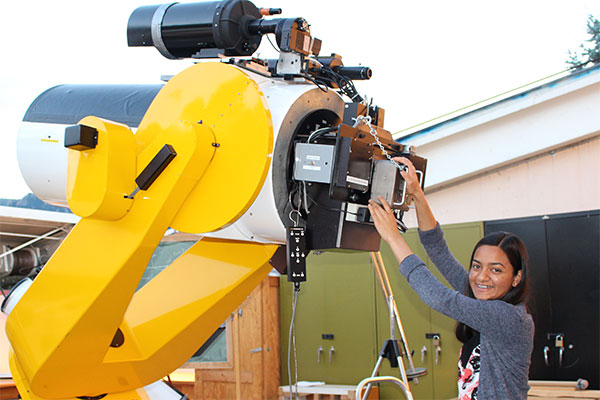 In 2013, 14-year-old Maya Burhanpurkar of Ontario won a major science fair for her research on Alzheimer’s Disease. Her prize? A trip to the Arctic Circle. “I was excited to see polar bears and be a tourist, so I brought along a video camera,” Burhanpurkar says. But when she met people dramatically affected by melting ice caps, her priorities changed. “Climate change gets drilled into you in school, but as more of a buzzword than as something that’s destroying cultures right now,” she says. So Burhanpurkar used her video footage to help create 400 PPM, a nonprofit, open-source documentary featuring Inuits explaining how melting ice destroys their ability to provide for their families. Since its 2015 release, 2.2 million students have viewed it worldwide. The 17-year-old says, “I hope my film motivates young people to tackle that next big idea, rather than thinking, I’m too young; I’ll wait.”
In 2013, 14-year-old Maya Burhanpurkar of Ontario won a major science fair for her research on Alzheimer’s Disease. Her prize? A trip to the Arctic Circle. “I was excited to see polar bears and be a tourist, so I brought along a video camera,” Burhanpurkar says. But when she met people dramatically affected by melting ice caps, her priorities changed. “Climate change gets drilled into you in school, but as more of a buzzword than as something that’s destroying cultures right now,” she says. So Burhanpurkar used her video footage to help create 400 PPM, a nonprofit, open-source documentary featuring Inuits explaining how melting ice destroys their ability to provide for their families. Since its 2015 release, 2.2 million students have viewed it worldwide. The 17-year-old says, “I hope my film motivates young people to tackle that next big idea, rather than thinking, I’m too young; I’ll wait.” On a volunteer trip to an Indian orphanage, Meghana Reddy met some kids with missing limbs. She tried to get them prosthetics but found the options crude and prohibitively expensive. Back home in San Diego, Reddy, then 15, convinced her parents to get an at-home 3-D printer, with which she made limbs for her friends in India. They worked so well that in 2014, Reddy started a nonprofit, Limbs With Love, as well as high school clubs, through which classmates help custom-design and create free-of-charge prosthetics. She’s now developing prosthetics with electric sensors. “Ideally, they’ll increase finger functionality and sensory perception,” says Reddy, who plans to go into biotech. “I’d like to continue to help people through healthcare-oriented business models.”
On a volunteer trip to an Indian orphanage, Meghana Reddy met some kids with missing limbs. She tried to get them prosthetics but found the options crude and prohibitively expensive. Back home in San Diego, Reddy, then 15, convinced her parents to get an at-home 3-D printer, with which she made limbs for her friends in India. They worked so well that in 2014, Reddy started a nonprofit, Limbs With Love, as well as high school clubs, through which classmates help custom-design and create free-of-charge prosthetics. She’s now developing prosthetics with electric sensors. “Ideally, they’ll increase finger functionality and sensory perception,” says Reddy, who plans to go into biotech. “I’d like to continue to help people through healthcare-oriented business models.”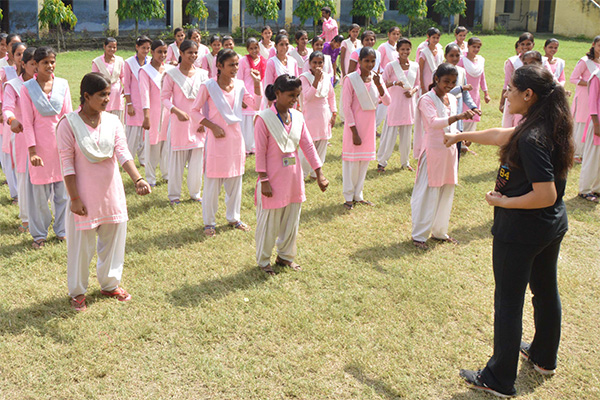 When martial artist Pooja Nagpal learned of 2012’s brutal Nirbhaya gang rape case in New Delhi, she traveled from her home in California to a rural Indian village to train young women in self-defense and, soon thereafter, founded For a Change, Defend, a nonprofit promoting gender equality and self-defense for women. Nagpal works with the government of India to implement her defense curriculum in schools and orphanages, and has taught sex-trafficking victims to defend themselves. Now a freshman studying electrical engineering and computer science at the University of California at Berkeley, Nagpal says, “I’d love to go into the social impact side of the tech industry.” To that end, she’s already developing a campus-safety app for women.
When martial artist Pooja Nagpal learned of 2012’s brutal Nirbhaya gang rape case in New Delhi, she traveled from her home in California to a rural Indian village to train young women in self-defense and, soon thereafter, founded For a Change, Defend, a nonprofit promoting gender equality and self-defense for women. Nagpal works with the government of India to implement her defense curriculum in schools and orphanages, and has taught sex-trafficking victims to defend themselves. Now a freshman studying electrical engineering and computer science at the University of California at Berkeley, Nagpal says, “I’d love to go into the social impact side of the tech industry.” To that end, she’s already developing a campus-safety app for women.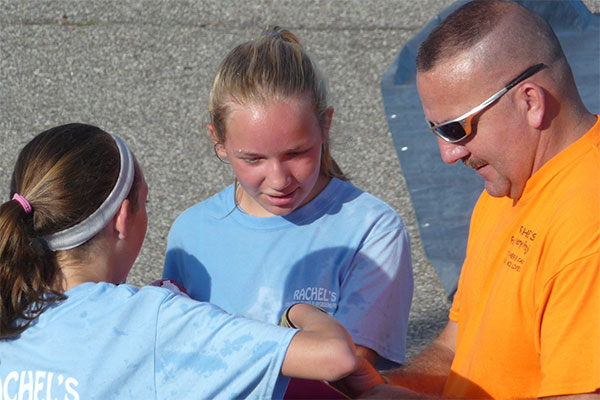 The sight of disabled children sitting on the sidelines of her local playground inspired Rachel Ritchie to spearhead an effort to build a fully accessible one. Then 10, Ritchie brought her concerns to the mayor of Garden Grove, Kentucky, who pledged space in a city park. In the two years since then, Ritchie has raised $85,000 of the playground’s required $100,000 by designing and selling T-shirts and organizing community charity events through her nonprofit, Rachel’s Fun for Everyone Project. While researching playground design and manufacturers, Ritchie, who wants to be a doctor when she grows up, learned to “never take no for an answer.” Construction on the accessible playground of her dreams is scheduled to break ground this spring.
The sight of disabled children sitting on the sidelines of her local playground inspired Rachel Ritchie to spearhead an effort to build a fully accessible one. Then 10, Ritchie brought her concerns to the mayor of Garden Grove, Kentucky, who pledged space in a city park. In the two years since then, Ritchie has raised $85,000 of the playground’s required $100,000 by designing and selling T-shirts and organizing community charity events through her nonprofit, Rachel’s Fun for Everyone Project. While researching playground design and manufacturers, Ritchie, who wants to be a doctor when she grows up, learned to “never take no for an answer.” Construction on the accessible playground of her dreams is scheduled to break ground this spring.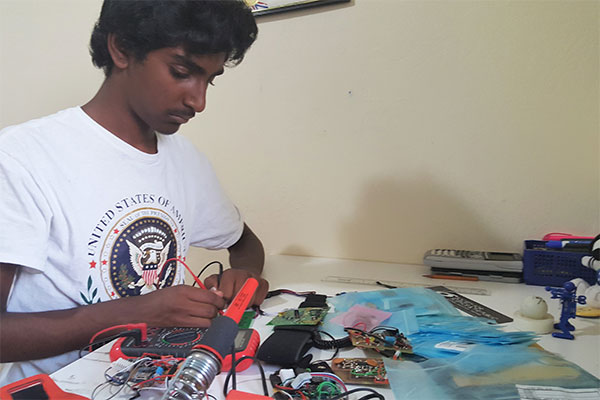 When Raghav Ganesh was in sixth grade, he saw a documentary detailing daily life for the visually impaired and was stunned to learn that standard, white canes were the only mobility aid widely available to the blind. “I thought they could use a technological update,” says the 14-year-old from San Jose, California. Before long, Ganesh invented SmartWalk, a 21st-century cane fitted with electronic “eyes” to sense objects well beyond canes’ reach, so as to help the blind better navigate obstacles. Ganesh, who wants to go into tech and become a social entrepreneur, is already working to further miniaturize his device and to reduce the cost, “so it can be useful to as many cane users as possible.”
When Raghav Ganesh was in sixth grade, he saw a documentary detailing daily life for the visually impaired and was stunned to learn that standard, white canes were the only mobility aid widely available to the blind. “I thought they could use a technological update,” says the 14-year-old from San Jose, California. Before long, Ganesh invented SmartWalk, a 21st-century cane fitted with electronic “eyes” to sense objects well beyond canes’ reach, so as to help the blind better navigate obstacles. Ganesh, who wants to go into tech and become a social entrepreneur, is already working to further miniaturize his device and to reduce the cost, “so it can be useful to as many cane users as possible.”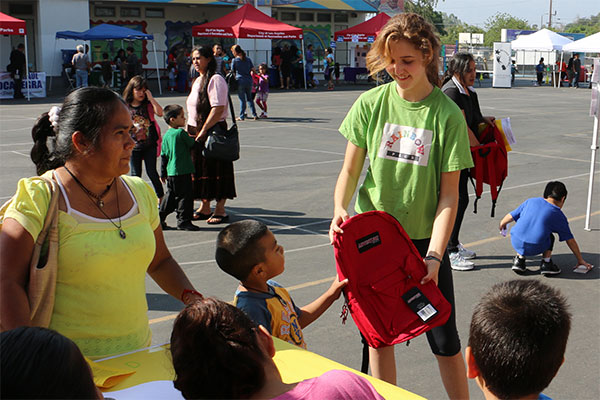 Volunteering in an underserved Los Angeles public school in 2011, Riley Gantt, then 10, overheard a little girl mention that her mother couldn’t afford crayons. “I could not accept the fact that there was a kindergartner who didn’t have something so simple for school,” says Gantt, who immediately gathered donated goods to provide the school with 360 backpacks—enough for every kindergartner and first-grader—stuffed with learning supplies. From there, Gantt went on to found a nonprofit around her mission of equipping every LAUSD student with basic homework supplies. To date, Rainbow Pack has gifted more than 9,500 such backpacks. “Long term, we hope to not have to exist,” says Gantt, now 15. “We’re testing a program through which LAUSD will automatically provide homework-supply sacks to children in high-need schools.”
Volunteering in an underserved Los Angeles public school in 2011, Riley Gantt, then 10, overheard a little girl mention that her mother couldn’t afford crayons. “I could not accept the fact that there was a kindergartner who didn’t have something so simple for school,” says Gantt, who immediately gathered donated goods to provide the school with 360 backpacks—enough for every kindergartner and first-grader—stuffed with learning supplies. From there, Gantt went on to found a nonprofit around her mission of equipping every LAUSD student with basic homework supplies. To date, Rainbow Pack has gifted more than 9,500 such backpacks. “Long term, we hope to not have to exist,” says Gantt, now 15. “We’re testing a program through which LAUSD will automatically provide homework-supply sacks to children in high-need schools.”  When Ryan Stackpole was a high school freshman, he and his friends got into building their own computers. “We wanted to do it to play video games, but my parents pushed me to find a more constructive outlet,” says Stackpole, now a senior in Greenwich, Connecticut. Upon learning of the One Laptop Per Child initiative to equip children throughout the developing world with laptops, he thought, “This is great, but a desktop is less likely to be stolen, and is cheaper and easier to repair.” Stackpole also figured that if kids learned how to build desktops themselves, they’d gain a valuable life skill. He brought his idea to a school advisor, and before long, found himself en route to a Kenyan orphanage, 500 pounds of computer parts in tow. Stackpole has since founded TechCorps: Geeks for Good and trained more than 300 students to build 100 computers, and is now using his prize winnings to implement a self-sustaining, 300-chicken farm at the orphanage. “These kids weren’t getting enough nutrition—protein, specifically—and it’s hard to learn on an empty stomach,” he says. So, he launched an independent study, through which classmates stateside help develop sustainable farming strategies and work with Kenyan pen pals to implement them.
When Ryan Stackpole was a high school freshman, he and his friends got into building their own computers. “We wanted to do it to play video games, but my parents pushed me to find a more constructive outlet,” says Stackpole, now a senior in Greenwich, Connecticut. Upon learning of the One Laptop Per Child initiative to equip children throughout the developing world with laptops, he thought, “This is great, but a desktop is less likely to be stolen, and is cheaper and easier to repair.” Stackpole also figured that if kids learned how to build desktops themselves, they’d gain a valuable life skill. He brought his idea to a school advisor, and before long, found himself en route to a Kenyan orphanage, 500 pounds of computer parts in tow. Stackpole has since founded TechCorps: Geeks for Good and trained more than 300 students to build 100 computers, and is now using his prize winnings to implement a self-sustaining, 300-chicken farm at the orphanage. “These kids weren’t getting enough nutrition—protein, specifically—and it’s hard to learn on an empty stomach,” he says. So, he launched an independent study, through which classmates stateside help develop sustainable farming strategies and work with Kenyan pen pals to implement them.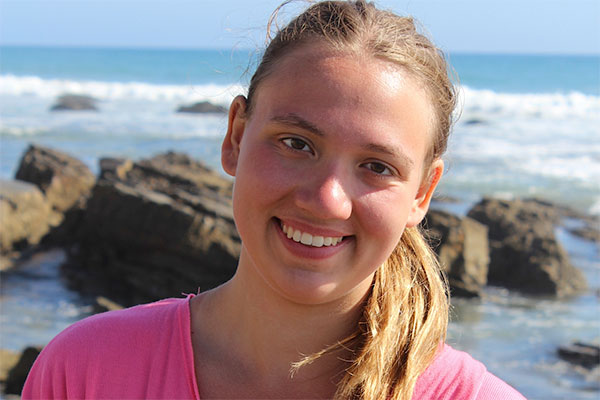 When Samantha “Sami” Petersen was 11, the competitive swimmer was diagnosed with scoliosis. Her condition and self-esteem deteriorated until, at 15, Petersen underwent surgery to fuse her vertebrae into a solid pillar. To combat the social stigma so often associated with scoliosis, Petersen documented her recovery on social media and afterward continued to work on behalf of sufferers via awareness projects and donation drives. Petersen was dismayed one day to learn her donations to a Honduran hospital were being declined because the hospital was closing—meaning child scoliosis patients stood to die due to lack of screening. That’s when Petersen founded SHIFT Scoliosis, a nonprofit committed to eliminating late diagnosis. In traveling to impoverished places such as South Dakota’s Cheyenne River Sioux Reservation, Petersen’s SHIFT team has screened more than 4,000 children and connected 150 with medical care. Petersen, now 19, is working with medical professionals to develop a tool to simplify scoliosis screening, and also expanding SHIFT into countries in Asia and Africa, where children are dying due to late diagnosis. “The goal is to catch them before they need surgery, or else enable them to have the surgery, so they can lead a normal life,” says Petersen, who plans to study medicine and/or business—”something that’ll enhance the organization, so I can make SHIFT my career.”
When Samantha “Sami” Petersen was 11, the competitive swimmer was diagnosed with scoliosis. Her condition and self-esteem deteriorated until, at 15, Petersen underwent surgery to fuse her vertebrae into a solid pillar. To combat the social stigma so often associated with scoliosis, Petersen documented her recovery on social media and afterward continued to work on behalf of sufferers via awareness projects and donation drives. Petersen was dismayed one day to learn her donations to a Honduran hospital were being declined because the hospital was closing—meaning child scoliosis patients stood to die due to lack of screening. That’s when Petersen founded SHIFT Scoliosis, a nonprofit committed to eliminating late diagnosis. In traveling to impoverished places such as South Dakota’s Cheyenne River Sioux Reservation, Petersen’s SHIFT team has screened more than 4,000 children and connected 150 with medical care. Petersen, now 19, is working with medical professionals to develop a tool to simplify scoliosis screening, and also expanding SHIFT into countries in Asia and Africa, where children are dying due to late diagnosis. “The goal is to catch them before they need surgery, or else enable them to have the surgery, so they can lead a normal life,” says Petersen, who plans to study medicine and/or business—”something that’ll enhance the organization, so I can make SHIFT my career.”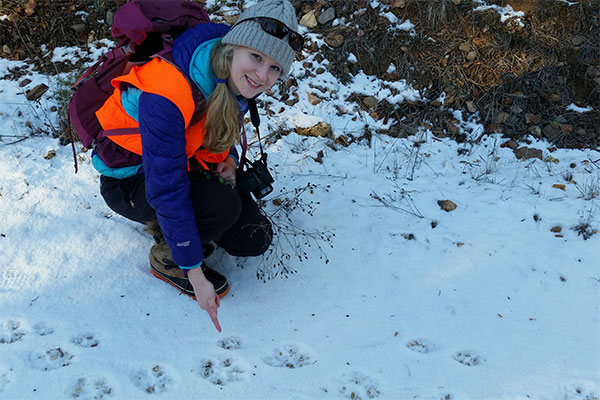 Story Warren’s fascination with wolves began at age six, when she saw her first one in Yellowstone and became hooked on researching the animal. In an effort to educate young people about wolves, and to promote coexistence between wolf advocates and those who oppose their recovery, Warren created Kids4Wolves, an outreach site and social media campaign in which she posts wolf facts and photos, mobilizing her 20,000-some followers to action. Today, Warren speaks to politicians and stakeholder groups about wolf science and has testified about nonlethal management strategies before federal and state fish and wildlife commissions. She also tracks wolves herself, in Yellowstone and in her home state of Washington, setting up field cameras and sharing data with wildlife biologists. “At first, I didn’t think I could make much of a difference in environmental policy, but people are impacted when kids get involved,” says Warren, now a high school senior planning to study wildlife biology and conflict resolution. “I realize more and more that it’s unfair to expect ranchers to change their livelihoods overnight,” she says, “so I’d like to work on the ground to help them protect their livestock.”
Story Warren’s fascination with wolves began at age six, when she saw her first one in Yellowstone and became hooked on researching the animal. In an effort to educate young people about wolves, and to promote coexistence between wolf advocates and those who oppose their recovery, Warren created Kids4Wolves, an outreach site and social media campaign in which she posts wolf facts and photos, mobilizing her 20,000-some followers to action. Today, Warren speaks to politicians and stakeholder groups about wolf science and has testified about nonlethal management strategies before federal and state fish and wildlife commissions. She also tracks wolves herself, in Yellowstone and in her home state of Washington, setting up field cameras and sharing data with wildlife biologists. “At first, I didn’t think I could make much of a difference in environmental policy, but people are impacted when kids get involved,” says Warren, now a high school senior planning to study wildlife biology and conflict resolution. “I realize more and more that it’s unfair to expect ranchers to change their livelihoods overnight,” she says, “so I’d like to work on the ground to help them protect their livestock.” Xerxes Libsch got into conservation at Westchester County, New York’s Muscoot Farm, where he attended camp for several summers. One day during a 2012 downpour, Libsch watched manure collecting in the barn and flooding away. “I kinda made the connection between a major problem in the real world and one I could work on,” he says. Since then, Libsch has led a four-year project to mitigate water contamination caused by farm-animal waste. He also secured donations and mobilized volunteers to help clear entire fields of invasive plants and to create a nature trail and environmental center, where campers and farm visitors can learn about soil and water conservation. “That way, I can continue my work even though I can’t be there as much,” says Libsch, now a freshman studying mechanical engineering at Princeton. Libsch, who says his passion lies at the intersection of conservation and engineering, is busy with a trash-management project. “Many companies burn their trash, which produces toxins,” Libsch says. “I’m trying to outfit incinerators with mesh filters, which should eat away a lot of the impurities.”
Xerxes Libsch got into conservation at Westchester County, New York’s Muscoot Farm, where he attended camp for several summers. One day during a 2012 downpour, Libsch watched manure collecting in the barn and flooding away. “I kinda made the connection between a major problem in the real world and one I could work on,” he says. Since then, Libsch has led a four-year project to mitigate water contamination caused by farm-animal waste. He also secured donations and mobilized volunteers to help clear entire fields of invasive plants and to create a nature trail and environmental center, where campers and farm visitors can learn about soil and water conservation. “That way, I can continue my work even though I can’t be there as much,” says Libsch, now a freshman studying mechanical engineering at Princeton. Libsch, who says his passion lies at the intersection of conservation and engineering, is busy with a trash-management project. “Many companies burn their trash, which produces toxins,” Libsch says. “I’m trying to outfit incinerators with mesh filters, which should eat away a lot of the impurities.”
We can’t wait to see what he—and each of his 14 hero peers—tackles next.

